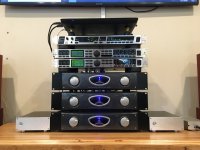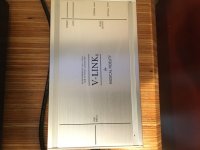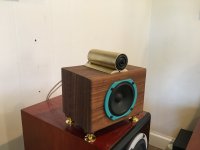Vance Dickason got slightly different distortion results too(10f/8414) could be due to the smaller motor, not chamfering(maybe), a different distortion measuring technique, or a combination of the three.
I typically don't compare distortion from one test setup to another. However it's an excellent indicator for sound quality performance when comparing different drivers/configurations in the same test setup. But generally I would expect distortion to be at least below 0.50% as my personal standard (@ 1 meter)...I also run multiple sweeps increasing the SPL in 5dB increments until I reach 2% THD to get a sense of the maximum output. As I gradually increase the output volume there is a listening level where distortion is at it's lowest before it starts to rise again from stress due to higher SPL. Some speakers I test never get below 1% as I incrementally raise the output volume.
Joseph, I noticed you’ve created some front horns with the BG Radia Neo’s. I’ve helped Igor with some beta testing on Oppo headphones and WiFi players. Have you seen his new creations from Radian? New take on all the BG Radia stuff. Did some beautiful Coaxials too
Gorgeous horns by the way.
Thanks! I’ve been using RCF ND series of compression drivers. They have a lower FS compared to Radian allowing lower crossover points for the same size format of driver. The RCF ND-350 is especially nice.
The new planar from Radian that’s similar to the Neo8 doesn’t look happy playing down to 250Hz but I’m only judging by the published frequency response graph.
Just received the new SB Acoustic 3” full ranges. Cute little buggers. 2” radiating diameter. Even though the thin plastic basket spokes give me pause, I’m sure the SB Acoustic engineers did their homework.
Last edited:
The 10F/8414 is $70 and very similar. For simple sealed box and high passed above 200Hz will work just as well as 8424 which has a bigger motor to drive smaller enclosures.
By the way, I totally agree with your approach, and the time/phase alignment technique(I was a Dunlavy guy before I got into diy), as long as relatively short stands are used, of course. I’m all digital, so that aspect isn’t needed in my design. All I need to do is set up the mic and press a button. Anyway, You have a beautiful, elegant design.
To eliminate the floor bounce cancelation(220hz in this case), I’m running the subs up to 60 hz, the bass drivers from 60 to 300 hz, and the midbass drivers from 300 hz to 600 hz.
Last edited:
I’m making another identical enclosure for the new, 3” fiberglass, SB Acoustic drivers. Gonna do a head to head. At $17 apiece, it would be a great, low cost alternative to the 10f’s
The thing that really impresses me about the 10f, used as an ultra wideband tweeter, is that
1. It has outstanding dispersion for a 3.5” driver, somewhat comparable to a 1” tweeter(Except for extreme off axis angles, which isn’t necessarily a bad thing)
2. The CSD is as good as any tweeter in the high frequencies
3. High order harmonic distortion is, for all intents and purposes, non existent in the treble range
4. It’s extremely inexpensive for the performance you get
5. It’s as “efficient” as it needs to be in this role, especially if the 4ohm version is used.
6. It would be essentially bulletproof
1. It has outstanding dispersion for a 3.5” driver, somewhat comparable to a 1” tweeter(Except for extreme off axis angles, which isn’t necessarily a bad thing)
2. The CSD is as good as any tweeter in the high frequencies
3. High order harmonic distortion is, for all intents and purposes, non existent in the treble range
4. It’s extremely inexpensive for the performance you get
5. It’s as “efficient” as it needs to be in this role, especially if the 4ohm version is used.
6. It would be essentially bulletproof
Last edited:
Oh yeah, and the most important aspect of using it this way is to get the crossover Completely out of the ears sensitive region. It seems very counterintuitive to plop a crossover right smack in the middle of the 1 to 5khz range, where most of the delicate spacial cues are located along with most of the important aspects of HRTF
Last edited:
Another driver that would be an interesting candidate for a wideband tweeter. They list it under “poly“, but it, like the 10f, is actually poly coated fiberglass. Very flat response from 500hz and up. The 8ohm version is a little less flat than this one.
https://www.parts-express.com/pedocs/specs/295-154--dayton-audio-pc83-4-specifications.pdf
https://www.parts-express.com/pedocs/specs/295-154--dayton-audio-pc83-4-specifications.pdf
And this, but the 12khz peak is pretty high, and the efficiency is pretty low.
https://www.madisoundspeakerstore.com/images/products/sb10pgc21-4.jpg
https://www.madisoundspeakerstore.com/images/products/sb10pgc21-4.jpg
A look at my electronics from top to bottom(Except for the “Musical Fidelity V link”, to the far right, which converts the USB signal from the computer to an SPDIF signal, which can then be used by the DSP devices in the system)
1. On top is the computer, which is used for streaming from the Amazon HD service. It’s also connected to the 65” tv for viewing selections.
2. The V link, as mentioned above.
3. Behringer ultramatch pro, which upsamples and reclocks data(jitter reduction). The digital output is then split and fed into..
4. Two Behringer Ultradrives, one for bass frequencies the other for mids and highs.
5. Three Behringer amplifiers, used only for bass(The top one operates up to 600hz.
6. IcePower amps(from kits)
(To the sides of the Behringer amps, which are being run(In this case) from 600hz and up
1. On top is the computer, which is used for streaming from the Amazon HD service. It’s also connected to the 65” tv for viewing selections.
2. The V link, as mentioned above.
3. Behringer ultramatch pro, which upsamples and reclocks data(jitter reduction). The digital output is then split and fed into..
4. Two Behringer Ultradrives, one for bass frequencies the other for mids and highs.
5. Three Behringer amplifiers, used only for bass(The top one operates up to 600hz.
6. IcePower amps(from kits)
(To the sides of the Behringer amps, which are being run(In this case) from 600hz and up
Attachments
This review just came out. Kind of like what I'm doing...kind of. What a mess though, and for only $11,000!
Rethm Maarga loudspeaker Measurements | Stereophile.com
Rethm Maarga loudspeaker Measurements | Stereophile.com
A look at my bass and midbass speakers..
10” Peerless XXLS Subs. One per channel and crossed over at 60hz, 8th order
6.5” Peerless HDS bass drivers, crossed over at 60 and 300hz, 8th order
5” Peerless HDS midbass drivers, crossed over at 300 and 600hz, 8th order
I designed the system this way to allow extreme control of the bass and midbass frequencies, without forcing any of the drivers to do electromechanical backflips in the process.
10” Peerless XXLS Subs. One per channel and crossed over at 60hz, 8th order
6.5” Peerless HDS bass drivers, crossed over at 60 and 300hz, 8th order
5” Peerless HDS midbass drivers, crossed over at 300 and 600hz, 8th order
I designed the system this way to allow extreme control of the bass and midbass frequencies, without forcing any of the drivers to do electromechanical backflips in the process.
Attachments
For the last step, I’ve added a super tweeter with an
8th order crossover at 7khz. This tweeter operates flat up to 40khz
Once again, my main objective with this project was to keep the crossover points well away from the ear’s sensitive range. The 8ohm 10f is extremely flat up to 7khz, where the fr starts to gently rise. ThIs is the perfect place for the Super tweeter to take over.
8th order crossover at 7khz. This tweeter operates flat up to 40khz
Once again, my main objective with this project was to keep the crossover points well away from the ear’s sensitive range. The 8ohm 10f is extremely flat up to 7khz, where the fr starts to gently rise. ThIs is the perfect place for the Super tweeter to take over.
Attachments
....but of course, I'm going to try several different crossover points for the supertweeter. You never really know until you actually listen 🙂
If anyone is interested, the brass parts came from “Online Metals” and the tweeter is the Peerless Ot19nc00-04
The Ot19’s rear cup is metal( it looks like plastic), so care needs to be taken to make sure the terminals don’t short out on the rear cups or the brass tube.
The Ot19’s rear cup is metal( it looks like plastic), so care needs to be taken to make sure the terminals don’t short out on the rear cups or the brass tube.
Last edited:
- Home
- Loudspeakers
- Multi-Way
- Teal Thiel SS10f mid/tweets





